Gordon Thomas Piney Strong was born on the 13 May 1919, and came from Exeter. At the time of his enlistment he was working as a seedsman. [1]
He enlisted into the Royal Armoured Corps, at Warminster, on the 3 October 1939, but was posted to the 57th Heavy Training Regiment, RA most likely for Signals Training. [2] & [2b]
He was appointed as an unpaid acting Lance Corporal on the 25 April 1940. [3]
In June 1940 he answered the call for volunteers to join a Commando unit that would be specialising in parachuting and was attached to No 2 Commando on the 1st July 1940, as a Trooper, but a week later he was promoted to Lance Corporal, again. [3]
He did the very first parachute course at RAF Ringway in July 1940, and was awarded his parachute badge on the 1st October 1940, and as a founder member was one of only a hundred who held the original George Quilter cap badge. He also did the No 1 Advanced Parachute Course at RAF Ringway, 4 – 11 January 1942.
On the 9 December 1940 he was officially listed as attached to the 11th Special Air Services Battalion. This was re-organised into the 1st Parachute Battalion in August/September 1941, and Lance Corporal Strong was now serving in 3 Section, No 4 Platoon, ‘R’ Company under the command of 2/Lieut DJI Davies, although he, along with twenty others had already been earmarked for the Signals Platoon. [3] & [4]
By October 1942, as the Battalion was getting ready to go to North Africa, to take part in Operation ‘Torch’, Gordon Strong was a Corporal serving in the Signals Platoon. [5]
He took part in the parachute operation at Souk-el-Arba in Tunisia, on the 16 November 1942, and the subsequent campaign in North Africa from then until May 1943. It was during the battles in the area of Tamera in March 1943 that he particularly distinguished himself and was later awarded the Military Medal.
‘For conspicuous gallantry and devotion to duty. On 10th March 43 in the TAMERA Sector (Tunisia Sheet 10) a strong enemy force attacked Bn HQ. Cpl Strong immediately organised the Bn signallers and personally led a counter-attack which succeeded in breaking up the enemy attack. Cpl Strong, by his leadership and initiative and complete disregard for his own safety saved Bn HQ from being overrun, and he managed to hold the enemy until a strong counter-attack was put in which completely dispersed the enemy.’
This award was recommended by Lieut-Colonel AS Pearson, the 1st Parachute Battalion Commander, and Brigadier. EWC Flavell, the Commander of the 1st Parachute Brigade, on the 25 March 1943. It was endorsed by the Commanders of both the 46th Infantry Division and 5th Corps, under whose command the unit was serving at the time, In April 1943. It was announced in the London Gazette on the 23 September 1943.
Gordon was appointed to the rank of Acting Sergeant on the 23 June 1943 [3] and then on the night of the 13/14 July 1943, he took part in the parachute operation in Sicily to secure the Primosole Bridge.
By the time the 1st Battalion left North Africa to go to Italy on Operation ‘Slapstick’, in September 1943 Gordon had been granted the War Substantive rank of Sergeant, and he was in charge of the Signals Platoon, a post he remained in until they returned to England in late 1943.
The Troop Ship docked at Liverpool on the 9th December 1943, and the battalion travelled overnight to their billets in the area of Bourne in Lincolnshire. Battalion Headquarters was established at Grimsthorpe Castle, just to the North-West of Bourne, and this is where Gordon was billeted.
On Tuesday, 28 March 1944 Sgt. Gordon Strong was amongst a large contingent of the 1st Airborne Division that attended an Investiture at Buckingham Palace, where he was to receive his Military Medal from H.M. The King. This was reported the next day in The Western Morning News;
HEROES AT PALACE
Medals For Men Of The West.
PRESENTED BY THE KING.
EXETER PARACHUTIST.
An Exeter man to be decorated with the Military Medal was Sgt. Wm. Strong, whose parents live at 7 Old Tiverton-road, Exeter. This award was for special service while in North Africa. He is well known in Exeter as a member of the Exeter Angling Association since he was ten years old. He won the association cup in 1938. Sgt. Strong was a scholar of Kenilworth College, and on leaving school worked with a Cathedral Yard firm. He was one of the first to volunteer for the parachute unit, and was one of the first to make the jump.. Sgt. Strong, who is 24, was married in 1942.
Gordon was well served by the Regimental Signals Officer, Lieut. James Lasenby, who had started off as a Lance Sergeant in the 1st Parachute Brigade Signals Section. He had then applied to be an officer and had been commissioned on the 31st May 1943, and was posted to the 1st Parachute Battalion in time for the parachute operation in Sicily. He would command the Signals Platoon at Arnhem.
Lieut. Lasenby and Sgt. Strong were supported by Lance Sergeant Stanley ‘Curly’ Platt, who had also been with the 1st Parachute Battalion since 1941 and had served in ‘Q’ Troop, 11th S.A.S. Battalion. He had then been put into 5 Platoon, ‘S’ Company upon the battalion’s conversion in August/September 11941, before moving to the Signals Platoon in time for operations in North Africa.
Sgt. Strong took off from Barkston Heath aerodrome, aboard a Dakota aircraft of the 61st Troop Carrier Group of the U.S.A.A.F., on Sunday, 17 September 1944, bound for DZ ‘X’ in Holland. This was part of Operation ‘Market’, the plan to capture the bridge at Arnhem, and he landed dropped successfully on the open farm land near Renkum and made his way to the battalion R.V. near a farm complex called Jonkershoeve. From here they set off on their assigned advance to the high ground North of Arnhem on route ‘LEOPARD’.
However, the battalion ran into strong German resistance and spent the next 48 hours battling their way into the Western outskirts of Arnhem, where Sgt. Strong was eventually captured – on Tuesday, 19 September 1944.
He was initially sent to Stalag 12A at Limburg in Germany, where he was assigned the POW No 89413, and he remained there until October 1944. This was only a Transit POW Camp, and he was then moved to Stalag 2A at Neubrandenburg. However, he was only there for a month before being moved to a Working Camp, 20 kms to the West at Varchentin. Here he was used as a labourer on a farm and for forestry work. He would remain here until liberated in May 1945. [1]
He was repatriated to the United Kingdom on the 10 May 1945, and after his survivors leave he was attached to the 176th Field Regiment, RA on the 27 July 1945. However, he was there for less than a month when he was posted to the Army Air Corps Holding Battalion, on the 18 August 1945. Four days later he was posted back to the 1st Parachute Battalion. [3]
He was released to the Z/T Reserves on the 29 April 1946. [2]
His overseas service is listed as:
North Africa 30.10.42 – 09.12.43
North West Europe 17.09.44 – 25.09.44
Prisoner of War 26.09.44 – 10.05.45
For his service he was issued with the following medals:
Military Medal
1939 – 45 Star
Africa Star with 1st Army clasp
Italy Star
France and Germany Star
Defence Medal
War Medal 1939 - 45
Gordon Strong died on the 7 May 2001.
A true family man, he married Ethel Cook of Manchester, youngest daughter of the family he was billeted with during his Ringway training. He leaves his loving wife, twin sons, three grandsons and a grand-daughter. [6]
Mrs Ethel Strong presented the medals, photographs, his personal documents and the George Quilter Cap Badge to Colonel Simon Barry, 1st Parachute Battalion at the Regimental Headquarters, The Parachute Regiment, Browning Barracks, Aldershot, HANTS. GU16 2BU on 5th June 2001 at 12.30 pm. All of these are now held at the Airborne assault Museum and Archives at Duxford.
NOTES:
[1] POW questionnaire. 7 May 1945.
[2] The Parachute Regiment Transfer & Enlistment Book 05, page 49.
[2b] Pay Book.
[3] Record of Service.
[4] 1st Parachute Battalion War Diary. 1941.
[5] 1st Parachute Battalion War Diary. 1942.
[6] From the Obituary by his son Chris.
Created with information and imagery kindly donated by R Hilton
Read More




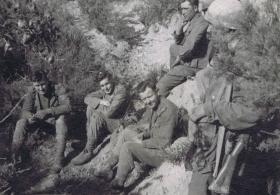
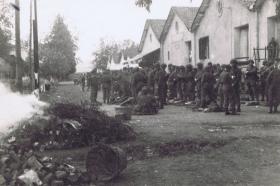
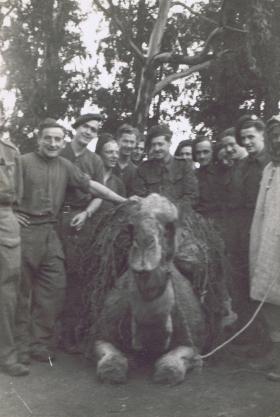
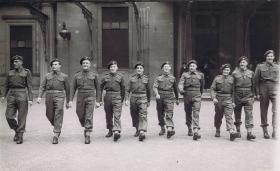
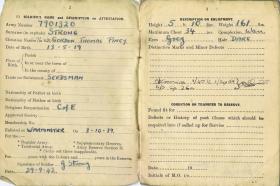
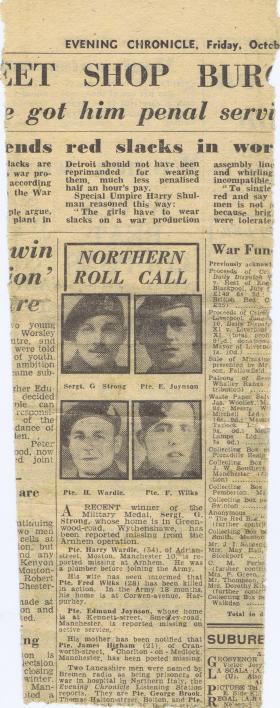
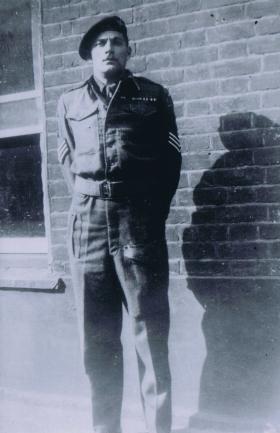
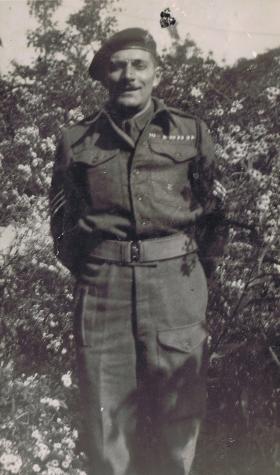
Latest Comments
There are currently no comments for this content.
Add Comment
In order to add comments you must be registered with ParaData.
If you are currently a ParaData member please login.
If you are not currently a ParaData member but wish to get involved please register.